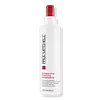What's inside
What's inside
 Key Ingredients
Key Ingredients

No key ingredients
 Benefits
Benefits

 Concerns
Concerns

 Ingredients Side-by-side
Ingredients Side-by-side

Water
Skin ConditioningPolyquaternium-4
Propylene Glycol
HumectantPvp
Emulsion StabilisingGlycerin
HumectantPhenoxyethanol
PreservativeCaprylyl Glycol
EmollientPolysorbate 20
EmulsifyingCitric Acid
BufferingParfum
MaskingTetrasodium EDTA
Panthenol
Skin ConditioningPEG-12 Dimethicone
Skin ConditioningSodium PCA
HumectantHydrolyzed Pea Protein
EmollientHydrolyzed Vegetable Protein
Skin ConditioningAchillea Millefolium Extract
CleansingCalendula Officinalis Flower Extract
MaskingChamomilla Recutita Flower Extract
MaskingCymbopogon Schoenanthus Extract
Skin ConditioningHumulus Lupulus Extract
AntimicrobialMelissa Officinalis Leaf Extract
Skin ConditioningPrunus Serotina Bark Extract
MaskingRosmarinus Officinalis Leaf Extract
AntimicrobialSalvia Officinalis Leaf Extract
CleansingUrtica Dioica Extract
AstringentLactobacillus/Tomato Fruit Ferment Extract
Skin ConditioningKeratin Amino Acids
Skin ConditioningOryza Sativa Extract
AbsorbentLinalool
PerfumingBenzotriazolyl Dodecyl P-Cresol
UV AbsorberLeuconostoc/Radish Root Ferment Filtrate
AntimicrobialAcyl Coenzyme A Desaturase
Skin ConditioningTris(Tetramethylhydroxypiperidinol)Citrate
StabilisingCI 16035
Cosmetic ColorantWater, Polyquaternium-4, Propylene Glycol, Pvp, Glycerin, Phenoxyethanol, Caprylyl Glycol, Polysorbate 20, Citric Acid, Parfum, Tetrasodium EDTA, Panthenol, PEG-12 Dimethicone, Sodium PCA, Hydrolyzed Pea Protein, Hydrolyzed Vegetable Protein, Achillea Millefolium Extract, Calendula Officinalis Flower Extract, Chamomilla Recutita Flower Extract, Cymbopogon Schoenanthus Extract, Humulus Lupulus Extract, Melissa Officinalis Leaf Extract, Prunus Serotina Bark Extract, Rosmarinus Officinalis Leaf Extract, Salvia Officinalis Leaf Extract, Urtica Dioica Extract, Lactobacillus/Tomato Fruit Ferment Extract, Keratin Amino Acids, Oryza Sativa Extract, Linalool, Benzotriazolyl Dodecyl P-Cresol, Leuconostoc/Radish Root Ferment Filtrate, Acyl Coenzyme A Desaturase, Tris(Tetramethylhydroxypiperidinol)Citrate, CI 16035
Sd Alcohol 40-B
AstringentWater
Skin ConditioningAcrylates/Hydroxyesters Acrylates Copolymer
Va/Crotonates/Vinyl Neodecanoate Copolymer
Algae Extract
EmollientSd Alcohol 40-B, Water, Acrylates/Hydroxyesters Acrylates Copolymer, Va/Crotonates/Vinyl Neodecanoate Copolymer, Algae Extract, Panthenol, Aminomethyl Propanol, Parfum, Amyl Cinnamal, Benzyl Alcohol, Citronellol, Eugenol, Hexyl Cinnamal, Hydroxycitronellal, Linalool, Butylphenyl Methylpropional, Limonene
Ingredients Explained
These ingredients are found in both products.
Ingredients higher up in an ingredient list are typically present in a larger amount.
Linalool is a fragrance and helps add scent to products. It's derived from common plants such as cinnamon, mint, citrus, and lavender.
Like Limonene, this ingredient oxidizes when exposed to air. Oxidized linalool can cause allergies and skin sensitivity.
This ingredient has a scent that is floral, spicy tropical, and citrus-like.
Learn more about LinaloolPanthenol is a common ingredient that helps hydrate and soothe the skin. It is found naturally in our skin and hair.
There are two forms of panthenol: D and L.
D-panthenol is also known as dexpanthenol. Most cosmetics use dexpanthenol or a mixture of D and L-panthenol.
Panthenol is famous due to its ability to go deeper into the skin's layers. Using this ingredient has numerous pros (and no cons):
Like hyaluronic acid, panthenol is a humectant. Humectants are able to bind and hold large amounts of water to keep skin hydrated.
This ingredient works well for wound healing. It works by increasing tissue in the wound and helps close open wounds.
Once oxidized, panthenol converts to pantothenic acid. Panthothenic acid is found in all living cells.
This ingredient is also referred to as pro-vitamin B5.
Learn more about PanthenolParfum is a catch-all term for an ingredient or more that is used to give a scent to products.
Also called "fragrance", this ingredient can be a blend of hundreds of chemicals or plant oils. This means every product with "fragrance" or "parfum" in the ingredients list is a different mixture.
For instance, Habanolide is a proprietary trade name for a specific aroma chemical. When used as a fragrance ingredient in cosmetics, most aroma chemicals fall under the broad labeling category of “FRAGRANCE” or “PARFUM” according to EU and US regulations.
The term 'parfum' or 'fragrance' is not regulated in many countries. In many cases, it is up to the brand to define this term.
For instance, many brands choose to label themselves as "fragrance-free" because they are not using synthetic fragrances. However, their products may still contain ingredients such as essential oils that are considered a fragrance by INCI standards.
One example is Calendula flower extract. Calendula is an essential oil that still imparts a scent or 'fragrance'.
Depending on the blend, the ingredients in the mixture can cause allergies and sensitivities on the skin. Some ingredients that are known EU allergens include linalool and citronellol.
Parfum can also be used to mask or cover an unpleasant scent.
The bottom line is: not all fragrances/parfum/ingredients are created equally. If you are worried about fragrances, we recommend taking a closer look at an ingredient. And of course, we always recommend speaking with a professional.
Learn more about ParfumWater. It's the most common cosmetic ingredient of all. You'll usually see it at the top of ingredient lists, meaning that it makes up the largest part of the product.
So why is it so popular? Water most often acts as a solvent - this means that it helps dissolve other ingredients into the formulation.
You'll also recognize water as that liquid we all need to stay alive. If you see this, drink a glass of water. Stay hydrated!
Learn more about Water